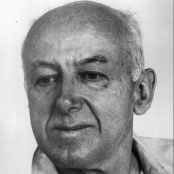 A
tireless musical explorer and inventor, Cowell was born 11 March 1897 in
Menlo Park, California, where he grew up surrounded by a wide variety of
Oriental musical traditions, his father's Irish folk heritage, and his
mother's Midwestern folktunes. Already composing in his early teens, Cowell
began formal training at age 16 with Charles Seeger at the University of
California. Further studies focused primarily on world music cultures.
His use of varied sound materials, experimental
compositional procedures, and a rich palette colored by multiple
non-European and folk influences revolutionized
American music and popularized, most notably, the tone
cluster as an element in compositional design.
A
tireless musical explorer and inventor, Cowell was born 11 March 1897 in
Menlo Park, California, where he grew up surrounded by a wide variety of
Oriental musical traditions, his father's Irish folk heritage, and his
mother's Midwestern folktunes. Already composing in his early teens, Cowell
began formal training at age 16 with Charles Seeger at the University of
California. Further studies focused primarily on world music cultures.
His use of varied sound materials, experimental
compositional procedures, and a rich palette colored by multiple
non-European and folk influences revolutionized
American music and popularized, most notably, the tone
cluster as an element in compositional design.
In addition to tone clusters evident in such works as Advertisement and Tiger, Cowell experimented with the "string piano" in works like The Aeolian Harp and The Banshee where strings are strummed or plucked inside the piano. Studies of the musical cultures of Africa, Java, and North and South India enabled Cowell to stretch and redefine Western notions of melody and rhythm; mastery of the gamelan and the theory of gamelan composition led to further explorations with exotic instruments and percussion. Later, Cowell developed the concept of indeterminancy or "elastic form" in works like the Mosaic Quartet (where performers determine the order and alternation of movements).
Cowell's influence is legion, counting among his students John Cage, Lou Harrison, and George Gershwin. Cowell taught at the New School for Social Research in New York and also held posts at the Peabody Conservatory and Columbia University. A plethora of awards, grants, and honorary degrees was capped by his election in 1951 to the American Institute of Arts and Letters.